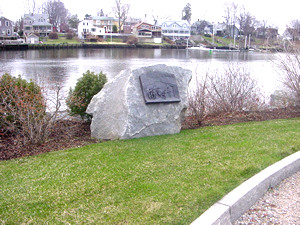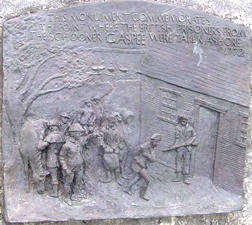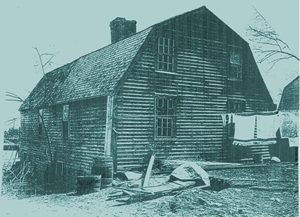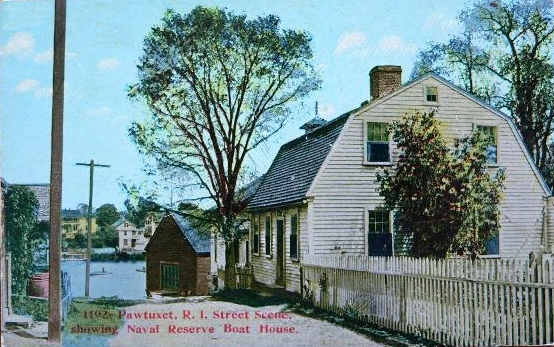Gaspee Virtual
Archives Virtual
Archives |
| Cellar Imprisonment of Gaspee Crewmen by Hazel Wade Kennedy |
  Left: Peck Lane,
Warwick, historical marker.
Located at the river's edge in Warwick,
the Peck
Lane
marker commemorates the site where the crew members of the Gaspee were
set ashore after the 'capture' of their ship on the night of June
9/10th,
1772. Crafted by 'G. Kane'. Pawtuxet Cove and
Pawtuxet Point are
in the background. Left: Peck Lane,
Warwick, historical marker.
Located at the river's edge in Warwick,
the Peck
Lane
marker commemorates the site where the crew members of the Gaspee were
set ashore after the 'capture' of their ship on the night of June
9/10th,
1772. Crafted by 'G. Kane'. Pawtuxet Cove and
Pawtuxet Point are
in the background.
THE POINT WHERE THE BRITISH PRISONERS FROM THE SCHOONER GASPEE WERE TAKEN ASHORE |

Left: Peck Lane cottage c late 19th
century Peck Lane was the first street laid out in Warwick in 1734 with two slips, each 20 feet wide at its shoreline. They were laid out by the town as docking places for the early commerce of Pawtuxet. It was also the site of Benjamin Smith's shipyard, where Pawtuxet ships, to be manned by Pawtuxet men, were built for the West Indies and southern coastal trade. Local tradition says that at the foot of this narrow street the captured crewmen from Gaspee were brought ashore on the night of June 9/10, 1772 and marched to an old farm house that stood on the south side of the lane. The seamen were hustled into the low-studded, earthen floored cellar through an outside cellarway and there confined for the night. Their stay was short because Deputy Governor Sessions, on his arrival the next morning, sent all the ship's company, except Lieutenant Dudingston, to the Beaver, the other British revenue schooner then at Newport. Commanding Lieutenant had received a musket ball in his stomach during the boarding conflict and was carried to Stillhouse Cove where today's Rhode Island Yacht Club stands. He was taken to Joseph Rhode's house 40 rods away, where he remained until his wounds healed. At the August session of the General Assembly, Deputy Governor Sessions was allowed his expenses for subsisting the Gaspee's crew during their stay at Pawtuxet and for sending them to the Beaver. Colonel Samuel Aborn of Pawtuxet Village owned a sloop named Sally and following the burning of the Gaspee, he brought to Pawtucket in his sloop, by order of the colony, what remained of the stores and guns of the King's ship. The sloop was later captured by a British Cruiser and Congress allowed Colonel Aborn $1,600 for loss of the vessel and its cargo. The British offered a $5,000 reward for the name of the leader of the burning of the Gaspee, but Abraham Whipple was never betrayed. At the outbreak of the American Revolution someone revealed the names of the men involved, but then Captain Whipple and several others were distinguished for their bravery during the struggle. Afterwards, Captain Whipple became a Commodore in the American Navy. An interesting closing in regards to the burning of the Gaspee is taken from the History of the United States by Benson Lossing: "Four years after, when Sir James Wallace, a British Commander, was in the vicinity of Newport, Captain Whipple became known as the leader of the attack. Wallace sent him the following letter, 'You, Abraham Whipple on the 9th of June 1772 burned his Majesty's vessel, the Gaspee and you will hang by the yard-arm.' To this Whipple replied, 'Sir, always catch a man before you hang him.' " The Gaspee Days Committee looks back remorsefully at the destruction of this old house on Peck Lane which could have been a local attraction and perhaps their own permanent headquarters. |
 Webmaster's
Addendum: In a personal communication from Henry A. L.
Brown, August, 2004, Brown writes that the last owner of this cottage,
Carl Bishop, sold the structure which was then carefully
dismantled. The chimney was removed brick by brick and
reinstalled in Carl Bishop's new home on Randall Street in the Warwick
Neck neighborhood. The framework was of post and beam
construction, and was re-erected c1962 as an addition to a house in the Town
of Foster, RI. In photo at left, the structure at the end of the
street is said to have been a shed used by the Naval Reserve. Webmaster's
Addendum: In a personal communication from Henry A. L.
Brown, August, 2004, Brown writes that the last owner of this cottage,
Carl Bishop, sold the structure which was then carefully
dismantled. The chimney was removed brick by brick and
reinstalled in Carl Bishop's new home on Randall Street in the Warwick
Neck neighborhood. The framework was of post and beam
construction, and was re-erected c1962 as an addition to a house in the Town
of Foster, RI. In photo at left, the structure at the end of the
street is said to have been a shed used by the Naval Reserve. |
| Back to Top | Back to Gaspee Virtual Archives |